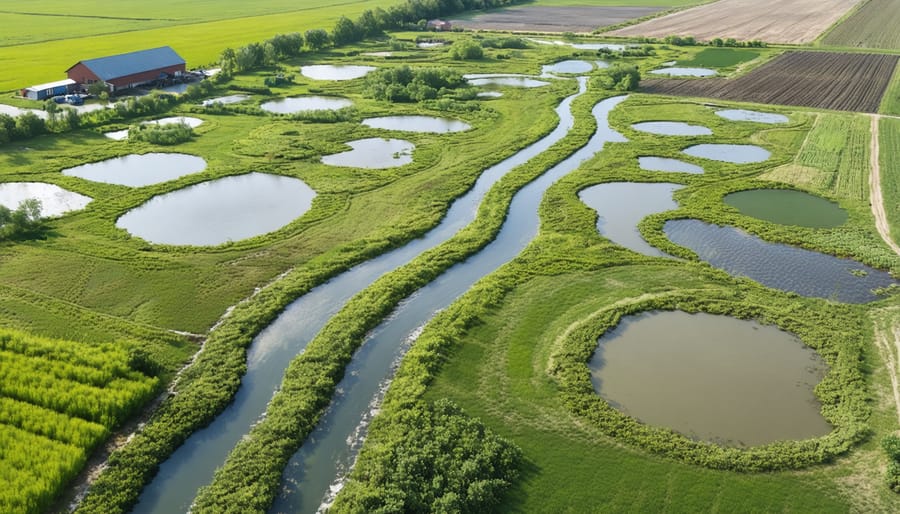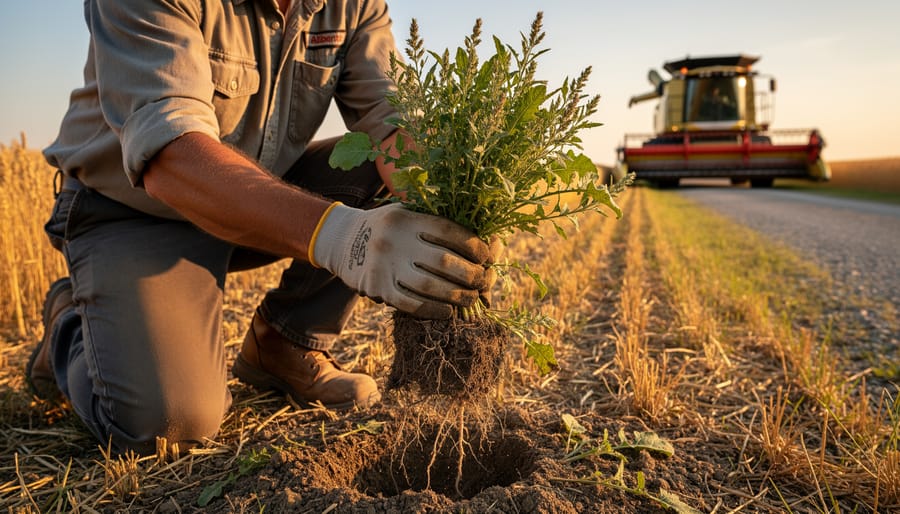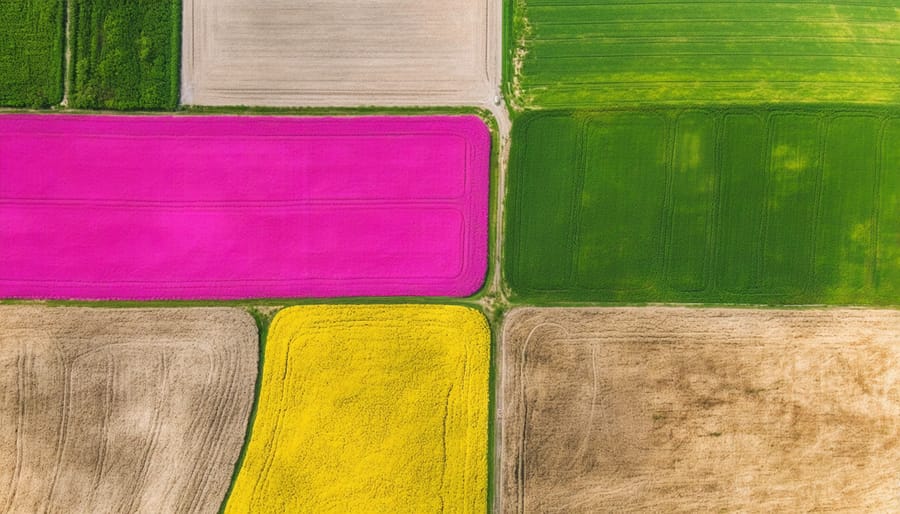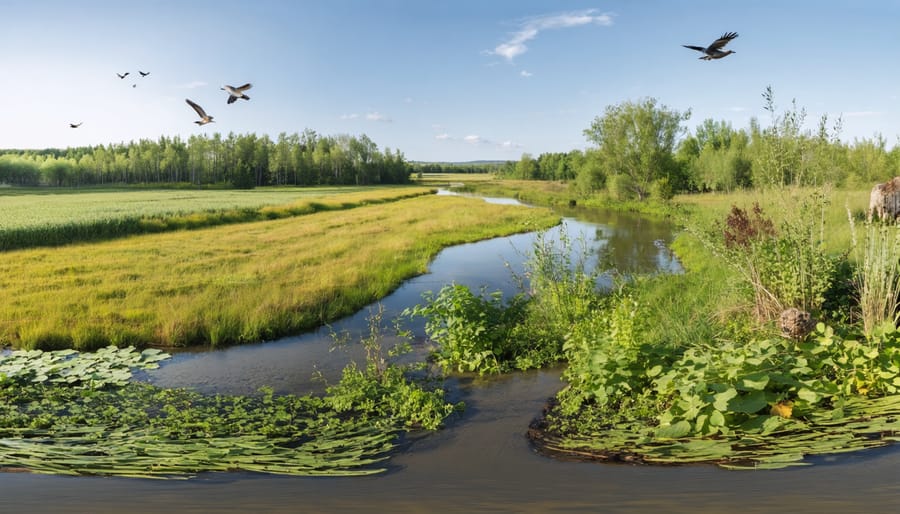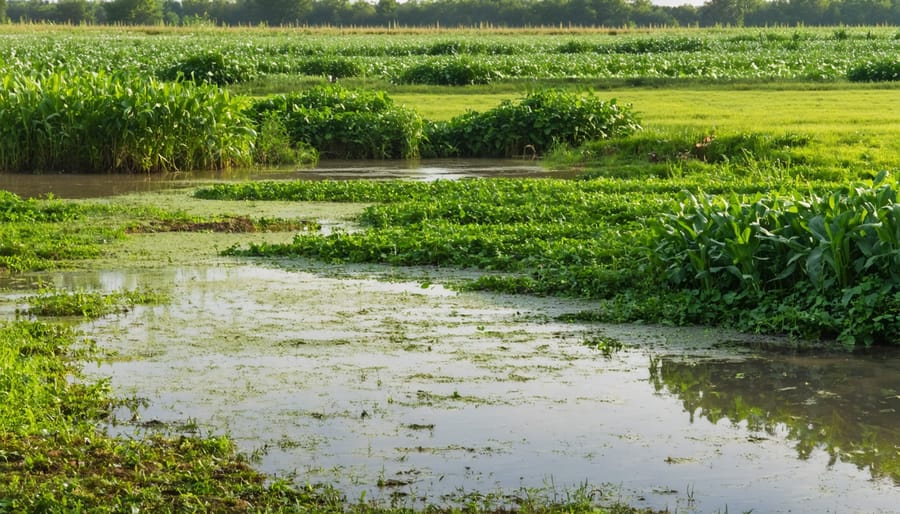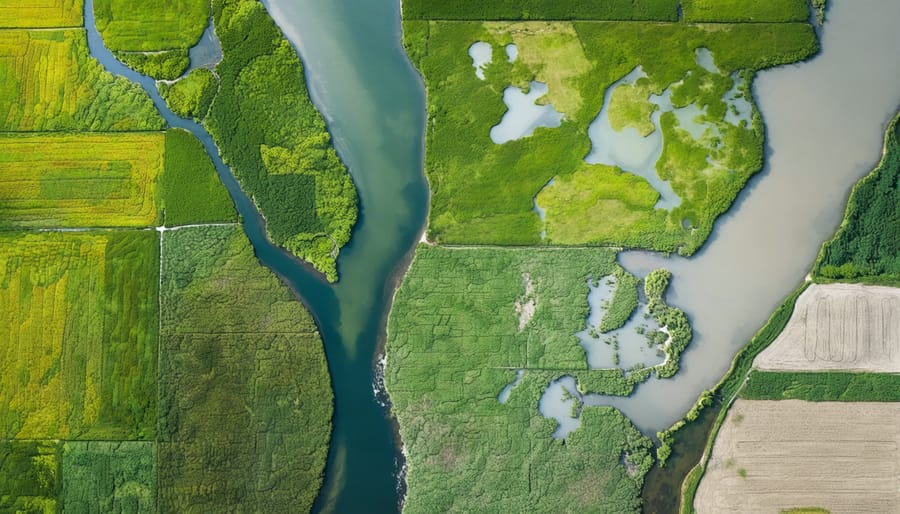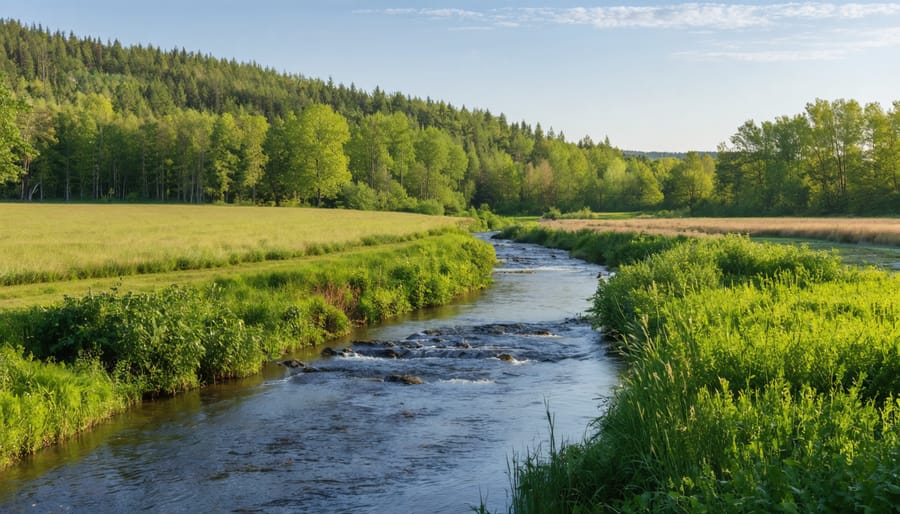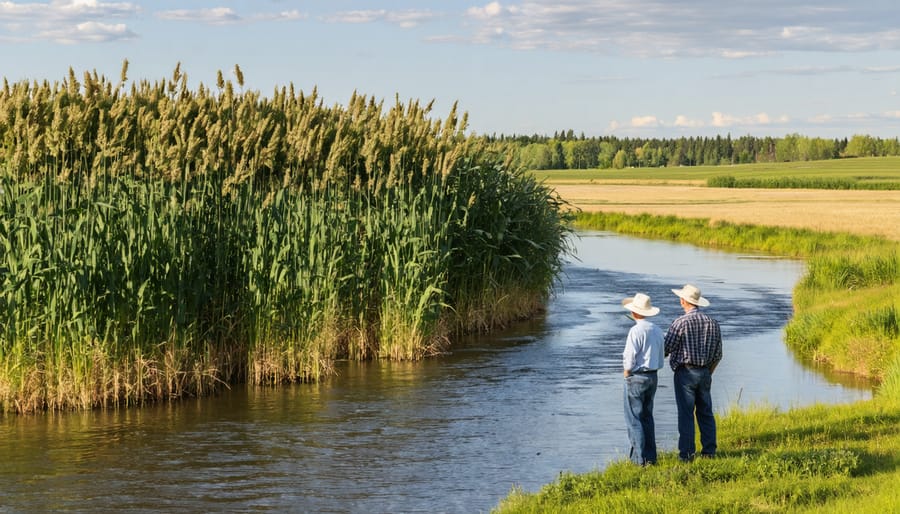Aquatic ecosystems transcend traditional biome classification, particularly in agricultural contexts where managed water systems create unique environments that blur the lines between natural and cultivated spaces. For Canadian farmers navigating the complexities of aquatic management, understanding these systems as dynamic, interconnected networks rather than simple biomes opens up powerful opportunities for sustainable agriculture.
From the fish-stocked dugouts of southern Alberta to the integrated irrigation systems of Saskatchewan’s croplands, agricultural water features function as specialized ecosystems that combine elements of multiple biome types. These managed aquatic environments support diverse life forms while serving crucial agricultural purposes – storing water, supporting livestock, and enabling crop production through irrigation.
Unlike natural biomes that evolve over millennia, agricultural aquatic systems are actively shaped by human intervention, requiring careful balance between productivity and ecological health. This distinction matters because it influences everything from water quality management to biodiversity planning on Canadian farms. By recognizing these systems as complex, managed environments rather than fitting them into traditional biome categories, farmers can better optimize their aquatic resources for both agricultural success and environmental sustainability.
Beyond Traditional Biome Classification
Defining Agricultural Aquatic Systems
In agricultural contexts, aquatic systems represent more than just natural water bodies – they’re carefully managed ecosystems that support food production and environmental sustainability. These systems include irrigation channels, farm ponds, constructed wetlands, and managed freshwater ecosystems in Alberta that serve multiple purposes beyond traditional farming.
Unlike natural biomes, agricultural aquatic systems are designed and maintained to achieve specific goals: water storage for irrigation, nutrient management, flood control, and even integrated fish farming. They typically feature controlled water levels, engineered drainage patterns, and carefully monitored water quality parameters.
What sets these systems apart is their hybrid nature – they combine elements of natural aquatic ecosystems with human-managed features. For instance, a farm pond might support native aquatic plants and wildlife while also functioning as an irrigation reservoir. This dual role makes them distinct from purely natural biomes, requiring specialized management approaches that balance agricultural productivity with ecological health.
Understanding these systems as managed ecosystems rather than simple biomes helps farmers make better decisions about their maintenance and sustainable use.
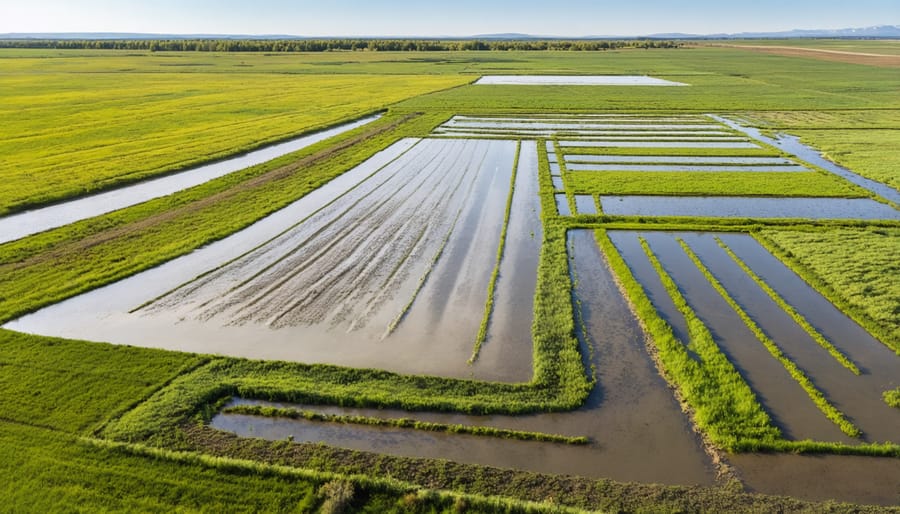
The Dynamic Nature of Farm Water Bodies
Farm water bodies are distinctly different from natural aquatic biomes, as they’re actively managed ecosystems that serve multiple agricultural purposes. Unlike natural lakes or ponds that develop over centuries, farm dugouts and irrigation reservoirs are purpose-built systems that require regular maintenance and monitoring.
Here in Alberta, these agricultural water bodies experience frequent changes due to seasonal variations, water withdrawal for irrigation, and livestock use. A typical farm dugout might see its water levels fluctuate significantly throughout the growing season, affecting water quality and the organisms that call it home.
These managed aquatic systems often support a unique blend of introduced and native species. For instance, many Alberta farmers stock their dugouts with specific fish species to control algae and insects, while also providing habitat for local wildlife. The nutrient levels in these water bodies are typically higher than natural systems due to agricultural runoff and livestock influence.
Unlike natural aquatic biomes that self-regulate, farm water bodies need active management to maintain their ecological balance and serve their intended agricultural purposes. This might include aeration systems, vegetation control, and regular water quality testing.
Aquatic Biodiversity in Alberta’s Farms
Common Water Features
In Alberta’s agricultural landscape, water features play a vital role in creating balanced farm ecosystems. Dugouts are perhaps the most common aquatic element, typically ranging from 3,000 to 5,000 cubic metres in size. These excavated ponds serve multiple purposes, from livestock watering to irrigation reserves and even small-scale fish farming operations.
Natural wetlands and sloughs dot many Alberta farms, supporting diverse wildlife while helping manage spring runoff and providing natural water filtration. These areas often connect to larger watershed systems through seasonal creek beds and natural drainage patterns.
Constructed wetlands are gaining popularity among forward-thinking farmers, with many incorporating them into their water management strategies. These engineered systems typically include settling ponds, vegetation zones, and deeper water areas that mimic natural wetland functions.
Irrigation canals and ditches form crucial connecting elements between water features, particularly in southern Alberta where water management is essential. Many farmers are now installing controlled drainage systems that allow better regulation of water levels throughout the growing season.
Stock ponds, specifically designed for livestock, usually feature gradual slopes and reinforced access points to prevent erosion. Progressive farmers are increasingly adding aeration systems and beneficial aquatic plants to maintain water quality and support healthy micro-ecosystems within these features.
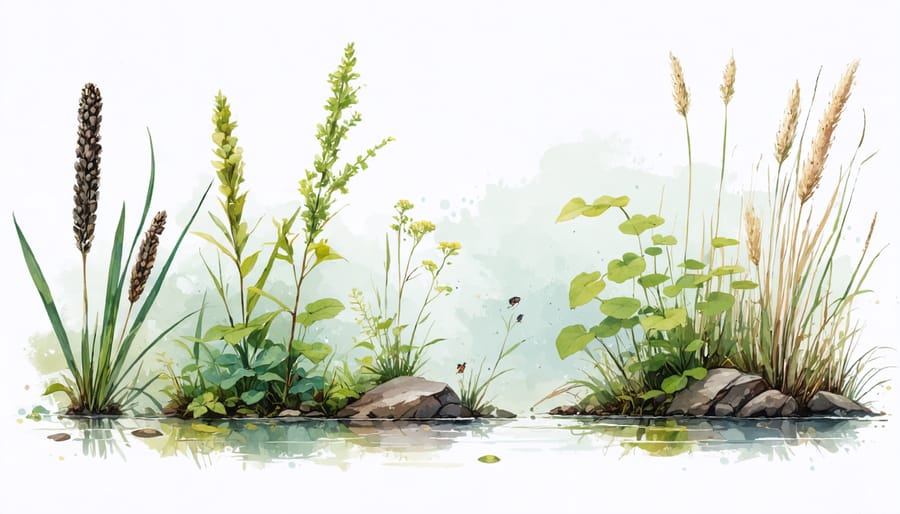
Native Species and Their Roles
In Alberta’s agricultural waterways, native aquatic plants and animals work together to create balanced ecosystems that benefit local farms. Species like Northern Pike help control pest fish populations, while freshwater mussels naturally filter water, improving quality for livestock and irrigation. Common Cattails and Bulrushes along water edges prevent erosion and trap excess nutrients from field runoff.
Beavers, though sometimes challenging to manage, create natural water retention systems that help during dry periods. Their dams slow water flow, creating deeper pools that sustain other beneficial species and provide emergency water reserves for farming operations.
Water Smartweed and Canadian Waterweed play crucial roles in oxygenating farm ponds and drainage ditches, supporting healthy fish populations that farmers can harvest as supplementary income. These plants also absorb excess nutrients, reducing algae growth that could harm livestock.
Local amphibians like the Western Toad and Wood Frog serve as natural pest controllers, managing insects that could damage crops. Understanding and working with these native species can reduce the need for chemical interventions and support more sustainable agricultural practices. Many Alberta farmers have found that protecting these natural systems leads to more resilient and productive farm operations.
Managing Farm Aquatic Systems
Sustainable Water Management
In Alberta’s agricultural landscape, effective water management is crucial for maintaining healthy aquatic ecosystems while supporting productive farming operations. Our local success stories show that sustainable practices can reduce water consumption by up to 30% while improving water quality.
Start by implementing a comprehensive water monitoring system to track usage and quality parameters. Many Alberta farmers have found success using soil moisture sensors and weather-based irrigation scheduling, which can help determine optimal watering times and amounts. Consider installing water meters at key points in your irrigation system to identify potential leaks and inefficiencies.
Regular maintenance of water infrastructure is essential. Clean and inspect irrigation equipment seasonally, repair leaks promptly, and consider upgrading to more efficient systems when possible. Many agricultural operations have benefited from converting to drip irrigation or low-pressure pivots, which can significantly reduce water waste.
Buffer zones along waterways play a vital role in maintaining water quality. Establish and maintain vegetated strips at least 10 metres wide along water bodies to filter runoff and prevent erosion. Native plants like cattails and sedges are particularly effective at nutrient uptake and soil stabilization.
Water recycling systems have shown promising results on several Alberta farms. Collecting and treating runoff water for reuse can reduce freshwater consumption by up to 40%. Consider implementing retention ponds or constructed wetlands, which can naturally filter water while providing additional wildlife habitat.
Remember to work with your local watershed group and agricultural extension services. They can provide valuable guidance on best practices specific to your region and help you access funding for water management improvements. Many successful projects in our province started with community collaboration and shared knowledge.
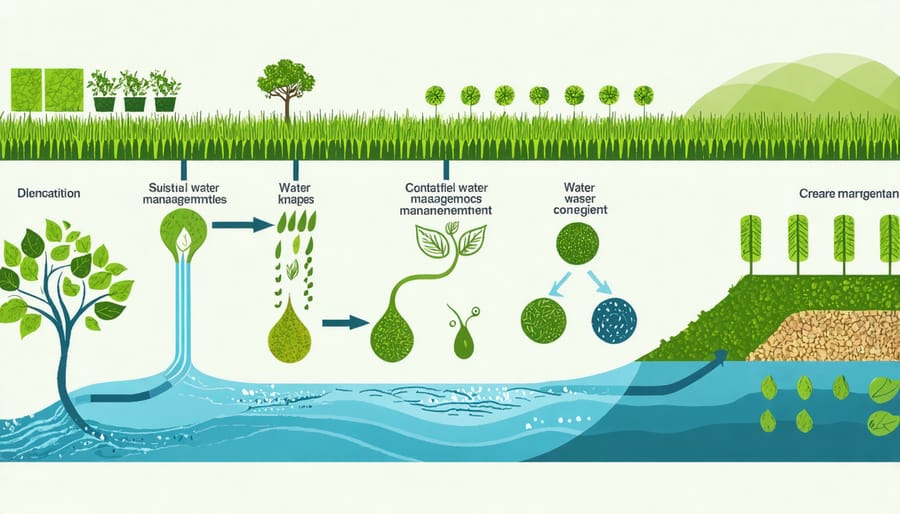
Enhancing Biodiversity
Creating thriving ecosystems in your farm’s water features isn’t just good stewardship – it’s smart farming. By promoting agricultural biodiversity, you’ll build more resilient water systems that work harder for your operation.
Start by establishing diverse aquatic plant communities along pond edges and in wetland areas. Native species like cattails, rushes, and sedges provide crucial habitat while helping filter water naturally. Aim for at least three different plant species per square metre to create varied wildlife niches.
Consider adding floating platforms or anchored logs to create basking spots for turtles and perches for birds. These simple additions dramatically increase habitat value. Installing fish structures like root wads or brush piles provides spawning areas and shelter for fish populations.
Maintain vegetated buffer strips at least 10 metres wide around water features to reduce erosion and filter runoff. Plant native grasses, wildflowers, and shrubs in these zones to support pollinators and beneficial insects.
Time maintenance activities thoughtfully – avoid disturbing nesting areas during breeding seasons and maintain different vegetation heights to accommodate various species. Consider establishing “no-mow” zones during critical wildlife periods.
For dugouts and irrigation ponds, install aeration systems to maintain healthy oxygen levels and prevent stagnation. This supports aquatic life while improving water quality for livestock and irrigation.
Remember that healthy biodiversity often translates to better water quality and reduced pest problems naturally. By creating these balanced ecosystems, you’re investing in your farm’s long-term sustainability while contributing to local wildlife conservation.
Integration with Crop Production
In Alberta’s diverse agricultural landscape, successful integration of aquatic systems with crop production requires careful balance and thoughtful management. Many farmers have discovered that well-managed water features can complement traditional farming practices while supporting essential ecosystem services. Understanding these farm water system benefits is crucial for sustainable agriculture.
Consider implementing buffer zones between croplands and water bodies, using native vegetation to filter runoff and prevent soil erosion. These zones, typically 10-30 metres wide, protect water quality while providing habitat for beneficial insects and birds that help with natural pest control.
Proper irrigation scheduling is essential – monitoring soil moisture levels and weather patterns helps optimize water use without overwhelming natural systems. Many Alberta farmers have found success using soil moisture sensors and weather station data to fine-tune their irrigation practices.
For those managing wetlands alongside crops, maintaining appropriate water levels during critical growing periods while ensuring sufficient water remains for aquatic life has proven beneficial. Local agricultural extension services recommend adjusting water management strategies seasonally, with particular attention to spring runoff and summer conservation.
Remember that healthy aquatic systems can serve as natural reservoirs during dry periods and help manage excess water during wet seasons. This dual functionality makes them valuable assets in our increasingly variable climate conditions.
As we’ve explored throughout this article, aquatic systems in agriculture are far more complex than simple biome classifications. They represent dynamic, managed ecosystems that require careful attention and strategic planning. For Alberta farmers, understanding this complexity is crucial for successful integration of aquatic elements into agricultural operations.
Remember that effective water management starts with assessing your specific farm conditions and goals. Consider implementing water quality monitoring systems, establishing riparian buffer zones, and developing sustainable irrigation practices. Many successful Alberta farmers have found that treating their farm’s aquatic features as interconnected systems rather than isolated elements leads to better outcomes.
Taking action doesn’t have to be overwhelming. Start with small steps like conducting regular water testing or consulting with local agricultural extension services. The Alberta Agriculture and Forestry department offers excellent resources and support for farmers looking to improve their aquatic system management.
Join local farmer networks and share experiences with others who are working with similar challenges. The collective knowledge of our farming community is one of our greatest assets. Consider participating in workshops offered by agricultural associations or connecting with experienced farmers who have successfully integrated aquatic elements into their operations.
By viewing your farm’s aquatic features as complex ecosystems rather than simple water bodies, you’ll be better equipped to make informed decisions that benefit both your agricultural productivity and environmental sustainability. Remember, sustainable aquatic management is a journey of continuous learning and adaptation.

